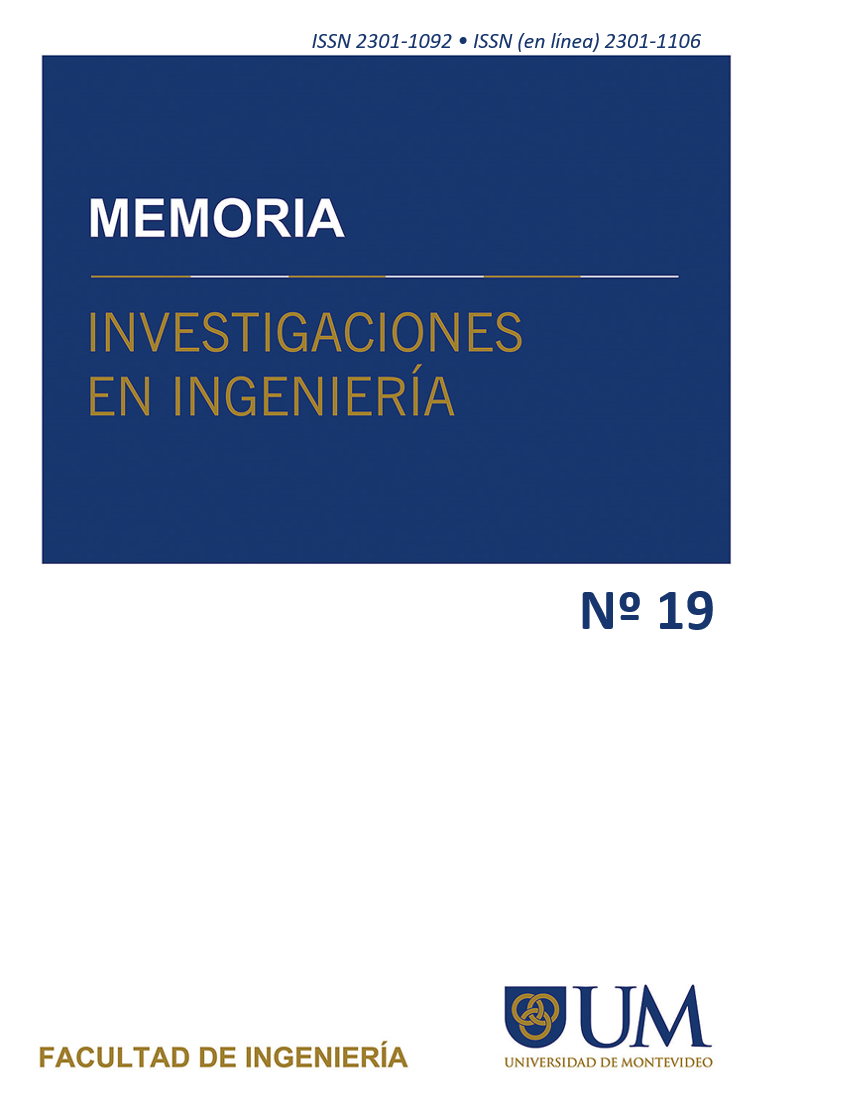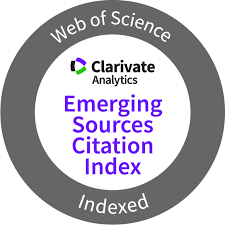Signage Recognition System in Open Environments for the Visually Impaired
DOI:
https://doi.org/10.36561/NG.19.4Keywords:
Signs, SLIC algorithm, Convolutional neural networks, Simple-board computer, GPS, People with visual disabilitiesAbstract
This work presents the development of a prototype that allows identifying specific signs through artificial vision techniques. It uses an image segmentation stage based on the SLIC superpixel algorithm, followed by a sign recognition and classification stage based on convolutional neural networks and has been implemented in a simple-board computer (SBC). The prototype informs the user of the identification of these signs through an audio message sent to headphones, it has a GPS module that obtains the location where the sign was recognized and is stored to offer the user notifications about nearby signs. The tests were performed with 1: 2 scale signs in open spaces, with natural light. The prototype is intended as a support for visually impaired people to move in open urban environments. Processing times and prototype performance are reported. Although the implementation in the selected simple-board computer makes its use unfeasible due to operating times, the functionality of the system is demonstrated.
Downloads
References
Organización Mundial de la Salud. "Temas de salud. Discapacidades". Available: https://www.who.int/topics/disabilities/es/ [Accessed: 20- octubre- 2020].
Instituto Nacional de Estadística y Geografía. "Estadísticas a propósito del día internacional de las personas con discapacidad (3 de diciembre). Datos nacionales". Comunicado de prensa núm. 638/19. 2-diciembre-2019.
Instituto Nacional de Estadística y Geografía. "Clasificación de tipo de discapacidad-Histórica". Available: https://www.inegi.org.mx/contenidos/clasificadoresycatalogos/doc/clasificacion_de_tipo_de_discapacidad.pdf [Accesed: 20-octubre-2020].
E A. Lafuente de Frutos, Educación inclusiva. Personas con discapacidad visual, 1º ed. Madrid: ITE, 2011, pp. 4-5.
Unión latinoamericana de ciegos. "La discapacidad visual y las tecnologías de la información y la comunicación". Available: http://www.ulacdigital.org/wp-content/uploads/2020/01/La-Discapacidad-Visual-y-las-Tecnolog%C3%ADas-de-la-Informaci%C3%B3n-y-la-Comunicaci%C3%B3n-1-1.pdf [Accesed: 20- octubre- 2020].
L. Nieto Riveiro y J. Muñoz Sevilla, "Aplicación de las tecnologías de la información y las comunicaciones en la vida diaria de las personas con discapacidad", 1º ed. A Coruña: Universidade da Coruña, Servizo de Publicacións, 2012, pp. 303-304.
D. Gbenga, A. Shani , A. Adekunle. "Smart Walking Stick for Visually Impaired People Using Ultrasonic Sensors and Arduino". International Journal of Engineering and Technology, 9(5), 2017, pp. 3435–3447.
S. Mohapatra, S. Rout, V. Tripathi, T. Saxena and Y. Karuna, "Smart Walking Stick for Blind Integrated with SOS Navigation System," 2018 2nd International Conference on Trends in Electronics and Informatics (ICOEI), Tirunelveli, 2018, pp. 441-447
S. Wang and Y. Tian, Camera-Based Signage Detection and Recognition for Blind Persons, ICCHP (Computers Helping People with Special Needs), 2012.
Tian, Y., Yang, X., Yi, C. et al. "Toward a computer vision-based wayfinding aid for blind persons to access unfamiliar indoor environments". Machine Vision and Applications 24, pp. 521–535, 2013.
D. Kunene y H. Vadapalli, "Indoor Sign Recognition for the Blind", SAICSIT (Annual Conference of the South African Institute of Computer Scientists and Information Technologists), Johannesburgo, Sudáfrica, 2016.
I. Goodfellow, Y. Bengio, A. Courville, Deep Learning. MIT Press, 2016. www.deeplearningbook.org
F. Chollet. Deep Learning with Python. Manning Publication Co, 2017.
M. Afif, R. ayachi, Y. Said, E. Pissaloux and M. Atri, "Recognizing signs and doors for Indoor Wayfinding for Blind and Visually Impaired Persons", 2020 5th International Conference on Advanced Technologies for Signal and Image Processing (ATSIP), Sousse, Tunisia, 2020, pp. 1-4.
F. Zanetti, "Convolutional Networks for Traffic Sign Classification". Tesis de Maestría. Department of Signal and Systems. Chalmers University of Technology, Göteborg, Suecia. Pp. 26, 2016.
Madan, Rishabh, Deepank Agrawal, S. Kowshik, Harsh Maheshwari, S. Agarwal and D. Chakravarty. “Traffic Sign Classification using Hybrid HOG-SURF Features and Convolutional Neural Networks.” ICPRAM, 2019.
Saleh, Shadi & Saleh, Hadi & Nazari, Mohammad & Hardt, Wolfram, "Outdoor Navigation for Visually Impaired based on Deep Learning". Actual Problems of System and Software Engineering (APSSE 2019), 2019.
Comité Internacional Pro Ciegos I. A. P., CDMX. Available: http://lugaresaccesibles.com/lugar/comite-internacional-pro-ciegos-iap-cdmx. [Accesed: 15-octubre-2020].
Información oficial del Gobierno de los Estados Unidos relativa al Sistema de Posicionamiento Global y temas afines. Sistema de posicionamiento global al servicio del mundo. Available: https://www.gps.gov/spanish.php [Accesed: 15-octubre-2020].
A. Krizhevsky, I. Sutskever, G. Hinton, "ImageNet Classification with Deep Convolutional Neural Networks". Neural Information Processing Systems. 25. 10, 2012.
K.Symonian, A. Zisserman, “Very deep convolutional networks for large-scale image recognition”, 2015.
Vezhnevets, Konouchine , “GrowCut” - Interactive Multi-Label N-D Image Segmentation By Cellular Automata, 2005.
N. Dalal, B. Triggs, "Histograms of oriented gradients for human detection". In Computer Vision and Pattern Recognition, 2005. CVPR 2005. IEEE Computer Society Conference on, volume 1, pages 886– 893. IEEE.
H. Bay, T. Tuytelaars, L.Van Gool, "Surf: Speeded up robust features". In Leonardis, A., Bischof, H., and Pinz, A., editors, Computer Vision – ECCV 2006, pages 404–417, Berlin, Heidelberg. Springer Berlin Heidelberg, 2006.
Secretaría de Comunicaciones y Transportes, Manual de Señalización Vial y Dispositivos de Seguridad, México, 2014, pp. 9.
M. Hart, "TinyGPS++ | Arduiniana", Arduiniana.org, 2014. [Online]. Available: http://arduiniana.org/libraries/tinygpsplus/. [Accessed: 19- mayo- 2019].
Stutz D., Hermans A., Leibe B. (2017). Superpixels: An Evaluation of the State-of-the-Art. Computer Vision and Image Understanding. doi: 10.1016/j.cviu.2017.03.007.
Achanta R., Shaji A., Smith K., Lucchi, A., Fua, P., Susstrunk. S. (2012). SLIC superpixels compared to state-of-the-art superpixel methods. IEEE Transactions on Pattern Analysis and Machine Intelligence, 34 (11): 2274–2281.
Ren X., Malik J. (2003). Learning a classification model for segmentation. International Conference on Computer Vision. Vol. 1: 10–17.
Achanta R., Shaji A., Smith K., Lucchi A., Fua P., Susstrunk S. (2010). SLIC Superpixels. EPFL Technical Report 149300
A. Hernández, Y. González, A. Morales (2017). Implementación de algoritmo de superpixeles para la segmentación de imágenes a color. Boletín UPIITA No. 61. Available: http://www.boletin.upiita.ipn.mx/index.php/component/content/article/9-articles/23-numeros-anteriores-cyt [Accessed: 27- junio- 2020].
Conversor texto-voz, Octubre 3, 2017, Available: https://es.wikipedia.org/wiki/Conversor-texto-voz.
Layer weight initializers. Usage of initializers. Available: https://keras.io/api/layers/initializers/ [Accessed: 25-octubre-2020].
Evaluación de modelos de clasificación: Matriz de confusión y curva ROC. http://ericmelillanca.cl/content/evaluaci-n-modelos-clasificaci-n-matriz-confusi-n-y-curva-roc [Accesed: 20-octubr-2020].
T. Fawcett, "An introduction to ROC analysis". Pattern Recognition Letters, 27, 861-874, 2006.
B. Zoph, V. Vasudevan, J. Shlens and Q. V. Le, "Learning Transferable Architectures for Scalable Image Recognition," 2018 IEEE/CVF Conference on Computer Vision and Pattern Recognition, Salt Lake City, UT, 2018, pp. 8697-8710, doi: 10.1109/CVPR.2018.00907.
G. Huang, Z. Liu, L. Van Der Maaten and K. Q. Weinberger, "Densely Connected Convolutional Networks," 2017 IEEE Conference on Computer Vision and Pattern Recognition (CVPR), Honolulu, HI, 2017, pp. 2261-2269, doi: 10.1109/CVPR.2017.243.
K. He, X. Zhang, S. Ren and J. Sun, "Deep Residual Learning for Image Recognition," 2016 IEEE Conference on Computer Vision and Pattern Recognition (CVPR), Las Vegas, NV, 2016, pp. 770-778, doi: 10.1109/CVPR.2016.90.






















